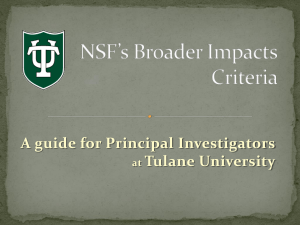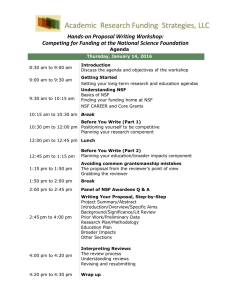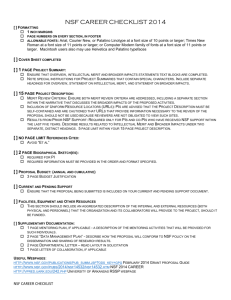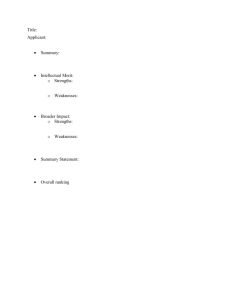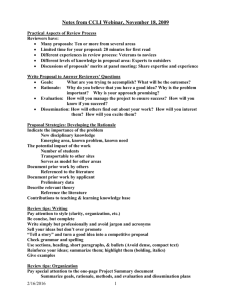A guide for Principal Investigators Tulane University at
advertisement
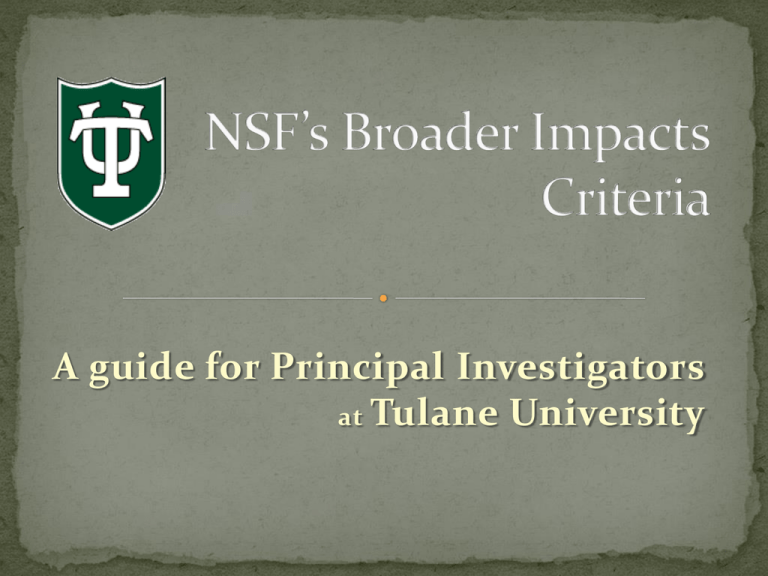
A guide for Principal Investigators at Tulane University NSF Broader Impacts Criteria at a glance 1. How well does the activity advance discovery and understanding while promoting teaching, training and learning? 2. How well does the proposed activity broaden the participation of underrepresented groups (e.g. gender, ethnicity, disability, geographic, etc.)? 3. To what extent will it enhance the infrastructure for research and education, such as facilities, instrumentation, networks and partnerships? 4. Will the results be disseminated broadly to enhance scientific and technological understanding? 5. What may be the benefits of the proposed activity to society? IMPORTANT: •Proposals are not required to address all five criteria. •The Broader Impacts criterion is often a “tiebreaker” for proposals of equal intellectual merit. •Reviewers are looking for feasible, realistically budgeted projects that are relevant to your proposal. IMPORTANT: Changes effective January 14, 2013 Dear Colleague Letter •Project summary will contain the following required separate statements: •Overview of the Project •Statement on Intellectual Merit •Statement on Broader Impacts •Proposing organizations must certify that sufficient organizational support will be made available •Annual and Final Reports must address activities related to the BI criteria that are not intrinsic to the research •Biosketches revised to rename “Publications” section to “Products” •Clarifications on IDC and NSF cost sharing policy IMPORTANT: Changes effective January 14, 2013 Changes to Merit Review Criteria: Reviewers will consider the following in the review of both BI and IM: • What is the potential for the proposed activity to a) advance knowledge and understanding within its own field or across different fields (Intellectual Merit); and b) benefit society or advance desired societal outcomes (Broader Impacts)? • To what extent do the proposed activities suggest and explore creative, original, or potentially transformative concepts? • Is the plan for carrying out the proposed activities well-reasoned, well-organized, and based on a sound rationale? Does the plan incorporate a mechanism to assess success? • How well qualified is the individual, team, or institution to conduct the proposed activities? • Are there adequate resources available to the PI (either at the home institution or through collaborations) to carry out the proposed activities? Section 526 of the America COMPETES Act of 2010 establishes goals and policies for BI Review Criterion: (1) Increased economic competitiveness of the United States. (2) Development of a globally competitive STEM workforce. (3) Increased participation of women and underrepresented minorities in STEM. (4) Increased partnerships between academia and industry. (5) Improved pre-K–12 STEM education and teacher development. (6) Improved undergraduate STEM education. (7) Increased public scientific literacy. (8) Increased national security. General tips, suggestions and guidelines (from funded PIs and NSF Reviewers): •Consult your Program Director specifically about Broader Impacts. •Keep a Web site, organize it carefully and update it often. Depending on the content, this could satisfy multiple criteria (education, dissemination, infrastructure, etc.) and serve as evidence of past service. •The vast majority of proposals use education/mentoring for Broader Impacts. Having a different or additional project can make your proposal stand out. •Build on existing programs. Start with Tulane Center for Public Service and the Center for Engaged Learning and Teaching (see following). Consult your department’s student organization. •Describe your research to colleagues in other departments. Would your research be useful in their field? How would your results benefit other disciplines? Could the outcome lead to interdepartmental collaboration? C.P.S. Center for Public Service http://tulane.edu/cps/ Alcee Fortier Hall (504) 862-8060 Vincent Ilustre, Executive Director vilustr@tulane.edu •Provides guidance in developing courses incorporating service learning •Identifies community projects for community-based independent study •Supports workshops/training sessions for relevant community partners •Connects PIs with community organizations interested in their research •Works with CPS community partners to disseminate research results •Acts as a liaison between PIs and community organizations • C.E.L. T. Center for Engaged Learning and Teaching http://tulane.edu/celt/ 310 Richardson Building (504) 314-7698 celt@tulane.edu •C.E.L.T. can partner with PIs on grants if they budget for a graduate student to supervise an outreach program during the summer. •C.E.L.T. may be able to provide some of the infrastructure for the broader impacts aspects of your project. Contacts: •Michael Cunningham, Executive Director mcunnin1@tulane.edu •Gary Talarchek, Assistant Director - Research Engagement gtalarch@tulane.edu 1. How well does the activity advance discovery and understanding while promoting teaching, training and learning? TRAINING: Provide specific examples of how trainees (undergraduate, graduate and postdoctoral) will be involved, including some verbiage describing how they will be trained. TEACHING: If appropriate, include undergraduate student training in the project and budget specifically for it. Describe your past work with undergraduate students. Consider applying for REU (Research Experiences for Undergraduates) supplements ( www.nsf.gov/crssprgm/reu/faculty/jsp) and discuss your plans in the text. DISSEMINATING: Describe your plans for publishing, presenting your findings at conferences, preparing invited reviews or book chapters, etc. If your trainees will disseminate findings as well, discuss it. Budget specifically for these activities, e.g., travel, meeting registration fees, publication costs for you and your trainees. 1. How well does the activity advance discovery and understanding while promoting teaching, training and learning? NSF Suggestions: Activities that go beyond the norm in conjunction with training of graduate students, mentoring postdoctoral researchers and junior faculty are highly encouraged. PIs are expected to go beyond their normal teaching duties and faculty commitments, and create opportunities that engage, excite, recruit and retain students at all levels. Seek opportunities to involve undergraduate and high school students in research experiences, participate in the professional development of K-12 teachers. Research activities can often contribute to updating the K-12 curriculum and take the form of new classroom instructional materials and experiments. 2. How well does the proposed activity broaden the participation of underrepresented groups (e.g., gender, ethnicity, disability, geographic, etc.)? NSF Suggestions: Broaden participation at all levels, from students through faculty members. Aim to use mentoring and outreach to junior faculty, women and minorities as avenues for increasing professional opportunities for groups that are underrepresented in science and engineering. Establish collaborations with students and faculty from institutions and organizations serving women, minorities and people with disabilities. Initiate or participate in the development of a diversity strategic plan within your department. 3. To what extent will it enhance the infrastructure for research and education, such as facilities, instrumentation, networks and partnerships? NSF Suggestions: Establish research collaborations with industry, national laboratories and international institutions. Develop new instrumentation, software, computation or data analysis methodologies that have a wide range of applicability and use. Upgrade existing computation and computing infrastructure, including advanced computing resources and new types of information tools (e.g., large databases, networks and associated systems, digital libraries). Share advanced laboratory/computational methods, instrumentation, software or samples of novel materials with other groups. Build national and international research and education networks. 3. To what extent will it enhance the infrastructure for research and education, such as facilities, instrumentation, networks and partnerships? •Mentor early-career scientists and engineers •Provide datasets and software for use in future studies •Encourage and increase faculty involvement in mentoring students at all levels •Webinars, teleconferencing with collaborators at other institutions/museums/schools/afterschool programs, etc. •Consult education specialists to ensure that your activities are feasible and cutting-edge. 4. Will the results be disseminated broadly to enhance scientific and technological understanding? NSF Suggestions: • Partner with museums, nature centers, science centers, etc., to develop exhibits in science, math, and engineering. Integrate research with education activities in order to communicate in a broader context. • Give science and engineering presentations to the broader community (e.g., at museums and libraries, on radio shows, and in other such venues.) • Make data available in a timely manner by means of databases, digital libraries, or other venues such as CDs, web, etc.; publish in diverse media (non-technical literature, websites, press kits) to reach broad audiences. • Present research and education results in formats useful to policy-makers, members of Congress, industry, and broad audiences. • Participate in multi- and interdisciplinary conferences, workshops, and research activities. 4. Will the results be disseminated broadly to enhance scientific and technological understanding? •Volunteer with Public Relations or other press as an expert/consultant in your field, available for comment on news stories, etc. •Include any magazine articles/TV interviews pertaining to your research. •Integrate research findings into classes you teach. 5. What may be the benefits of the proposed activity to society? NSF Suggestions: • Demonstrate the linkage between discovery and societal benefit by providing specific examples and explanations regarding the potential application of research and education results. • Partner with academic scientists, staff at federal agencies and with the private sector on both technological and scientific projects to integrate research into broader programs and activities of national interest. • Analyze, interpret, and synthesize research and education results in formats understandable and useful for non-scientists. • Provide information for policy formulation by Federal, State or local agencies. 5. What may be the benefits of the proposed activity to society? •Activities applicable to other criteria also apply here: Partnering with museums, making information available on Web sites, creating new software/databases, etc. •Create startup companies •Improve commercial technology •Inform public policy •Enhance national security Other resources Revised Merit Review Criteria Resources for Proposers: http://www.nsf.gov/bfa/dias/policy/merit_review/resources.jsp Center for the Integration of Research, Teaching and Learning (CIRTL) www.cirtl.net Louisiana Public Broadcasting “electronic field trips” for students in multiple states: http://beta.lpb.org/index.php/E-Trips/ or email edserv@lpb.org to suggest your own collaboration How to Leverage What You & Your Lab Already Do for Broader Impacts (Rick Keil, University of Washington) http://www.coseeolc.net/client/KEIL_Leveraging_BI_2011_v1.pdf NSF links regarding recruitment and retention: www.nsf.gov/mps/dmr/diversity.jsp Direct link to NSF BI examples: http://www.nsf.gov/pubs/gpg/broaderimpacts.pdf

